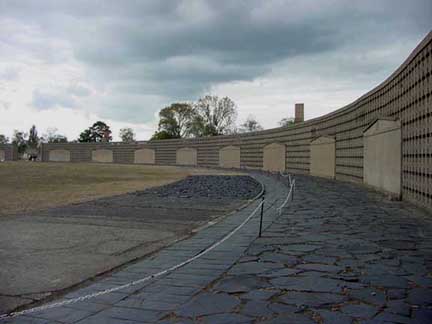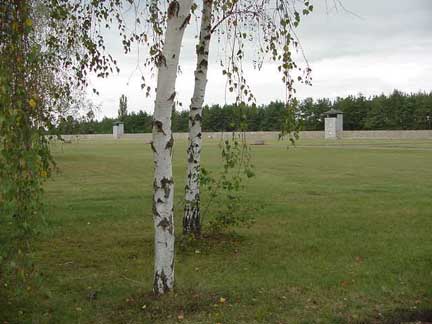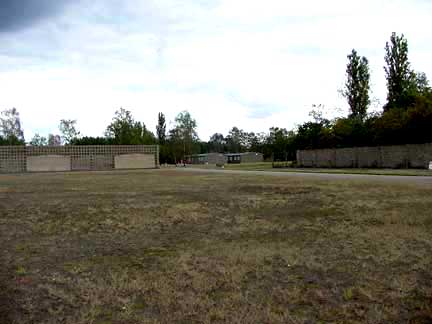Tour of Sachsenhausen Memorial Site  In 1953, the plan to build a National Memorial Site at the former Sachsenhausen concentration camp was initiated by some of the former political prisoners. In 1956, the architects Ludwig Deiters, Horst Kutzat and Kurt Tausendsschön were commissioned to design the site. All the barracks in the former concentration camp had been torn down in 1950 after the Germans who had been held prisoner by the Communists were released. The design of the Memorial Site included a semicircular wall which shows where the first line of barracks once stood, as shown in the first photograph above. The second photograph above shows the shape of one of the barracks, depicted in a bas relief on the wall. The Sachsenhausen Memorial opened on the grounds of the former concentration camp on April 23, 1961. Over 100,000 people participated in the opening ceremonies, which mainly honored the former Communist political prisoners of the Nazis. In 1995, the Memorial Site was extended to include the former German prisoners of the Communists. As you walk down the camp's center path toward the Monument in honor of the political prisoners, you will pass through a break in the wall, shown in the first photograph above. On the corner of the wall on the right hand side, there is a plaque which designates the spot where public hangings took place. The hangman was a prisoner named Paul Sakowski. He was convicted of war crimes by the Soviet Military Tribunal in 1947 and sentenced to 15 years in prison. He was released in 1972.  Just past the curved wall which denotes the first row of barracks, you will see two buildings located on opposites sides of the central path. The building on the right is the former camp kitchen, which has been converted into a museum. The building on the left is the former camp laundry; on my first visit to the Sachsenhausen Memorial in the fall of 1999, it housed a small museum devoted entirely to Harry Naujocks, a Communist who was the camp senior at Sachsenhausen. Although an inmate, his power in the camp was so great that when the Commandant ordered the execution of a prisoner, Naujocks was able to have him transferred instead to the Gross-Rosen concentration camp. Naujocks survived the camp and carried on his career as a Communist party member for many years after the war. On my second visit in the fall of 2002, the Naujocks display had been replaced by a new one featuring Walter Timm and his artwork. Timm was a prisoner at Sachsenhausen from 1943 to 1945 and he survived the death march when Sachsenhausen was evacuated on April 21, 1945. In 1937, Timm was arrested for violating Article 175 of the German Criminal Code which made public homosexual acts a crime. He was tried in the Muenster Regional Court and sentenced to six years in prison. After he finished his sentence, he was sent to Sachsenhausen as an "enemy of the state." After the war, Timm did a series of paintings and drawings about his experience in Sachsenhausen. There is also a movie theater in this building. On my first visit, it was showing a 30-minute film every two hours. The film was such blatant Soviet propaganda that, upon exiting the theater, incredulous visitors were handed a letter written by the director of the Memorial Center, dated August 22, 1996. The text of the letter said that the film was made in 1945 and 1946 and "is a typical product of its time" which was the result of "contemporary ignorance of the exact history and significance of the concentrations camps" and it represents the "political views held by the Allies, in this particular instance, the Soviet Union." This film, which was shown in the Memorial Site theater in 1999, entitled "The Sachsenhausen Death Camp," was entirely in German with no English sub-titles. It showed a German prisoner in the camp, giving a guided tour of the liberated camp to several men in Russian uniforms, one of whom was writing down every word. The prisoner explained the operation of the gas chamber at Sachsenhausen and also demonstrated how Russian POWs were shot in the neck, through a hole in the wall, while they were standing in front of a wooden measuring stick to determine their height. There were no shots of the actual liberation of the Sachsenhausen camp in the film, but some of the film clips I recognized as shots that were taken at Auschwitz-Birkenau when that camp was discovered by the Russians in January 1945. On my second visit in 2002, I did not see any sign outside the building which would indicate that the movie was still being shown there. I did obtain an Information Leaflet from the book store which showed a picture of the German prisoner in the film and he was identified as Paul Sakowski, the hangman who also worked in the Crematorium building where the gas chamber was located. I also learned, from another Information Leaflet which I purchased, that this film, "The Sachsenhausen Death Camp" was shown at the Soviet Military Tribunal as proof of the existence of a gas chamber, disguised as a shower room, at the Sachsenhausen camp. The film also shows six suitcases, filled with false teeth, which the Soviet Military Tribunal prosecutors claimed was their proof that 100,000 people had been murdered at Sachsenhausen. According to both the United States Holocaust Memorial Museum and the Simon Wiesenthal Center in Los Angeles, California, the death toll in the Nazi concentration camp at Sachsenhausen was around 30,000 out of a total prison population of 140,000. If these figures are correct, then the death rate in the Nazi camp was about the same as the death rate in the Communist prison camp which the Soviet occupation set up in the same barracks at Sachsenhausen. In the Communist camp, called Special Camp No. 7, there were approximately 12,000 deaths out of a prison population of 60,000. The letter from the Director, about the film, takes a pot shot at similar American and British concentration camp films by stating that this is a film "resembling other early films about concentration camps made in the USA and Great Britain." He was referring to the American film about Dachau which showed a gas chamber with similar pipes and control valves, and to the British film about Bergen-Belsen which failed to mention that there was a typhus epidemic in the camp which accounted for most of the deaths there. On the east side, to your right as you enter through the gate house, is the area where the Jewish barracks and the camp prison were located. The prison was torn down, but one section of it has been reconstructed. The photograph below shows the wall near the gate house. The area in front of the wall was called the "death strip" because prisoners who ventured onto the grass strip in front of the wall were immediately shot. This provided a way for prisoners to commit suicide when they could no longer bear the conditions in the camp.   To your right, after you have entered through the gate house, are the two reconstructed Jewish barracks, blocks 38 and 39, which have been converted into a Holocaust museum. To the left of the Jewish barracks is a reconstruction of the former camp prison. The photograph below shows the wall which represents the first row of barracks; the reconstructed prison block is hidden by the wall. Barracks 38 and 39 were built in 1938 when 6,000 Jews were brought to Sachsenhausen after the pogrom, known as Kristallnacht, on November 9th and 10th, 1938. This area was known as the "Small Camp" and it was used later to house Roma and Sinti prisoners. The first Jewish inmates of the "Small Camp" were released after a couple of weeks, if they promised to leave Germany and sign over all their property to the Nazis. After the Wannsee Conference on January 20, 1942, at which plans for the Final Solution to the Jewish Question were made, all the Jews in the Sachsenhausen camp were transported to the death camps in what is now Poland. When these camps were evacuated in 1944 and early 1945, some of the Jewish survivors were brought to Sachsenhausen.  The Jewish MuseumDeath MarchTrial of Commandant Anton Kaindl and 15 othersTable of ContentsHome |